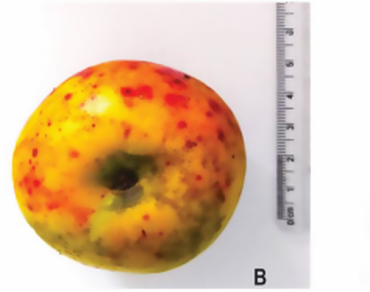Comparative biochemical evaluation of the proximate content, antioxidant properties, and phytochemical constituents of ethnomedicinally important Docynia indica from Northeast India
*Article not assigned to an issue yet
Rahman Mehzabin, Buragohain Rupam, Das Rodali, Islam Md Aminul, Hazarika Naba Kumar, Pathak Khusbu, Barman Pranjan
Research Articles | Published: 02 December, 2024
First Page: 0
Last Page: 0
Views: 1904
Keywords: Comparative profiling, Proximate, Antioxidant, Phytochemical, Wild apple, n Docynia indican
Abstract
Docynia indica (wild apple) is an underutilized wild edible fruit endemic to the Indo-Burma biodiversity hotspot having ethnomedicinal importance. In this study, we investigated the proximate, antioxidant, and biochemical aspects, focusing on alkaloids, phenolics, and flavonoids in D. indica. Antioxidant activity of methanolic extract of fruit, flower, and leaf were compared using 2,2 diphenyl-1-picrylhydrazyl and 2,2’-azino-bis (3-ethyle benzothiazoline-6-sulfonic acid) assay, total antioxidant content of all the three extracts were quantified by phosphomolybdenum assay. The percentage concentration of total alkaloids was estimated, and the total phenolic and flavonoid content of all three extracts was quantified. Comparative studies on carbohydrate and protein content reveal higher concentrations in flowers (58.25%) and leaves (73.5%) compared to fruit. Vitamin C content was found to be high in the leaf (0.98 mg/100 g) compared to fruit and flower. Methanolic extract of fruit, flower, and leaf showed effective results for antioxidant activity. Leaf extract was found to have the highest antioxidant activity with an IC50 value of 26.854 µg/mL for DPPH and 7.06 µg/mL for ABTS. The percentage alkaloid concentration was higher in the methanolic extract of the leaf (24%). Total phenolic and flavonoid content were also found to be higher in the methanolic extract of the leaf with (68.33 ± 0.0035 mg GAE/gm of extract) and (92.37 ± 0.001 mg QE/gm of extract), respectively. Leaf has more potential health benefits compared to fruit and flowers of Docynia indica with high antioxidant activity, phenolics, and flavonoid content. Further studies on its efficacy and molecular identification may lead to novel drug discovery.

References
Association of Official Analytical Chemists (AOAC) (2000) Official Methods of Analysis of AOAC International, 17th edn. AOAC International, Gaithersburg, MD, USA
Abitogun A, Borokini F, Ashogbon A (2010) Nutritional and Chemical composition of Ripe and Unripe Vitex Glandifolia. J Res Natl Dev 8(1):1–8
Agrahar-Murugkar D, Subbulakshmi G (2005) Nutritive values of wild edible fruits, berries, nuts, roots and spices consumed by the khasi tribes of India. Ecol Food Nutr 44(3):207–223. https://doi.org/10.1080/03670240590953025
Bharti SK, Krishnan S, Kumar A, Kumar A (2018) Antidiabetic phytoconstituents and their mode of action on metabolic pathways. Therapeutic Adv Endocrinol Metabolism 9(3):81–100
Biswas J, Barman P, Rahman M, Ghosh R (2021) A Comprehensive Review on the endemic plant Docynia indica: its Ethnobotanical, Phytochemical, and Ethnomedicinal Perspective. Asian J Biol Life Sci 10(3):515
Dewanjee S, Dua TK, Sahu R (2013) Potential anti-inflammatory effect of Leea macrophylla Roxb. Leaves: a wild edible plant. Food Chem Toxicol 59:514–520
Ebrahimzadeh MA, Pourmorad F, Bekhradnia AR (2008) Iron chelating activity, phenol and flavonoid content of some medicinal plants from Iran. Afr J Biotechnol 7(18):3188–3192
Gajera H, Gevariya SN, Hirpara DG, Patel S, Golakiya B (2017) Antidiabetic and antioxidant functionality associated with phenolic constituents from fruit parts of indigenous black jamun (Syzygium cumini L.) landraces. J Food Sci Technol 54(10):3180–3191
Harborne J (1984) Methods of plant analysis phytochemical methods. Springer, pp 1–36
Khomdram S, Barthakur S, Devi GS (2014) Biochemical and molecular analysis of wild endemic fruits of the Manipur Region of India. Int J Fruit Sci 14(3):253–266. https://doi.org/10.1080/15538362.2013.818483
Koleva II, Van Beek TA, Linssen JP, Groot Ad, Evstatieva LN (2002) Screening of plant extracts for antioxidant activity: a comparative study on three testing methods. Phytochemical Analysis: Int J Plant Chem Biochem Techniques 13(1):8–17
McDonald S, Prenzler PD, Antolovich M, Robards K (2001) Phenolic content and antioxidant activity of olive extracts. Food Chem 73(1):73–84
Nepal A, Chakraborty M, Sarma D, Kanti P (2021) Phyto-chemical characterization of Aeschynanthus sikkimensis (Clarke) Stapf.(Gesneriaceae) using GC-MS. Int J Pharm Res 13(3)
Olayiwola I, Akinfenwa V, Oguntona C, Sanni S, Onabanjo O, Afolabi W (2013) Phytonutrient, antioxidant and mineral composition of some wild fruits in south west Nigeria. Niger Food J 31(2):33–40
Pala FS, Gürkan H (2008) The role of free radicals in ethiopathogenesis of diseases. Adv Mol Biology 1(19):9
Peakall R, Smouse PE (2012) GenAlEx 6.5: genetic analysis in Excel. Population genetic software for teaching and research—an update. Bioinformatics 28(19):2537–2539. https://doi.org/10.1093/bioinformatics/bts460
Prieto P, Pineda M, Aguilar M (1999) Spectrophotometric quantitation of antioxidant capacity through the formation of a phosphomolybdenum complex: specific application to the determination of vitamin E. Anal Biochem 269(2):337–341
Rajeswari G, Murugan M, Mohan V (2012) GC-MS analysis of bioactive components of Hugonia mystax L.(Linaceae). Res J Pharm Biol Chem Sci 3(4):301–308
Re R, Pellegrini N, Proteggente A, Pannala A, Yang M, Rice-Evans C (1999) Antioxidant activity applying an improved ABTS radical cation decolorization assay. Free Radic Biol Med 26(9–10):1231–1237
Sen S, Passah T, Thubru K, Chakraborty R (2016) Comparative evaluation of nutritive value of some fruits available in North-East India. J North East India Stud 6:88–94
Sharma P, Handique PJ, Devi HS (2015) Antioxidant properties, physico-chemical characteristics and proximate composition of five wild fruits of Manipur, India. J Food Sci Technol 52(2):894–902
Suksathan R, Rachkeeree A, Puangpradab R, Kantadoung K, Sommano SR (2021) Phytochemical and nutritional compositions and antioxidants properties of wild edible flowers as sources of new tea formulations. NFS J 24:15–25
Ayyanar M, Subash-Babu P (2012) Syzygium cumini (L.) Skeels: a review of its phytochemical constituents and traditional uses. Asian Pac J Trop Biomed 2(3):240–246. https://pubmed.ncbi.nlm.nih.gov/23569906/
Author Information
Department of Biotechnology, Gauhati University, Jalukbari, Guwahati, India